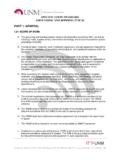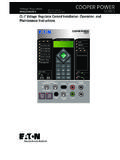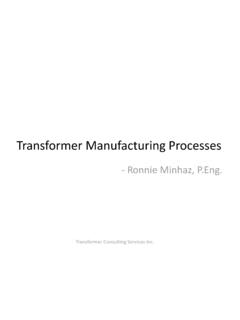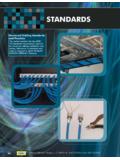Transcription of IEEE Std 450 450TM EEE Standards IEEE Standards
1 ieee Std 450 -2002(Revision of ieee Std 450-1995) ieee Standards450 TMIEEE Recommended Practice forMaintenance, testing , and Replacementof Vented Lead-Acid Batteries forStationary ApplicationsPublished by The Institute of Electrical and Electronics Engineers, Park Avenue, New York, NY 10016-5997, USA3 April 2003 ieee Power Engineering SocietySponsored by thePES Stationary Battery CommitteeIEEE StandardsPrint: SH95063 PDF: SS95063 The Institute of Electrical and Electronics Engineers, Park Avenue, New York, NY 10016-5997, USAC opyright 2003 by the Institute of Electrical and Electronics Engineers, rights reserved. Published 3 April 2003. Printed in the United States of is a registered trademark in the Patent & Trademark Office, owned by the Institute of Electrical and Electronics Engineers, Incorporated.
2 Print: ISBN 0-7381-3491-0 SH95063 PDF: ISBN 0-7381-3492-9 SS95063 No part of this publication may be reproduced in any form, in an electronic retrieval system or otherwise, without the prior written permission of the publisher. ieee Std 450 -2002 (Revision of ieee Std 450-1995) ieee Recommended Practice for Maintenance, testing , and Replacement of Vented Lead-Acid Batteries for Stationary Applications Sponsor PES Stationary Battery Committee of the ieee Power Engineering Society Approved 9 December 2002 ieee -SA Standards Board Abstract: Maintenance, test schedules, and testing procedures that can be used to optimize thelife and performance of permanently installed, vented lead-acid storage batteries used for standbypower applications are provided.
3 This recommended practice also provides guidance to determinewhen batteries should be replaced. This recommended practice is applicable to full-float stationaryapplications where a charger maintains the battery fully charged and supplies the dc loads. Keywords: acceptance test, battery capacity, battery installation, battery maintenance, batteryreplacement criteria, battery service test, battery terminal voltage, connection resistance measure-ments, electrolyte level, equalize charge, float voltage, modified performance test, performancetest, service test, specific gravity, standby power applications, state of charge, test-discharge rate,vented lead-acid battery ieee Standards documents are developed within the ieee Societies and the Standards Coordinating Committees of theIEEE Standards Association ( ieee -SA) Standards Board.
4 The ieee develops its Standards through a consensus develop-ment process, approved by the American National Standards Institute, which brings together volunteers representing variedviewpoints and interests to achieve the final product. Volunteers are not necessarily members of the Institute and serve with-out compensation. While the ieee administers the process and establishes rules to promote fairness in the consensus devel-opment process, the ieee does not independently evaluate, test, or verify the accuracy of any of the information containedin its of an ieee Standard is wholly voluntary. The ieee disclaims liability for any personal injury, property or other dam-age, of any nature whatsoever, whether special, indirect, consequential, or compensatory, directly or indirectly resultingfrom the publication, use of, or reliance upon this, or any other ieee Standard ieee does not warrant or represent the accuracy or content of the material contained herein, and expressly disclaimsany express or implied warranty, including any implied warranty of merchantability or fitness for a specific purpose, or thatthe use of the material contained herein is free from patent infringement.
5 ieee Standards documents are supplied AS IS . The existence of an ieee Standard does not imply that there are no other ways to produce, test, measure, purchase, market,or provide other goods and services related to the scope of the ieee Standard. Furthermore, the viewpoint expressed at thetime a standard is approved and issued is subject to change brought about through developments in the state of the art andcomments received from users of the standard. Every ieee Standard is subjected to review at least every five years for revi-sion or reaffirmation. When a document is more than five years old and has not been reaffirmed, it is reasonable to concludethat its contents, although still of some value, do not wholly reflect the present state of the art.
6 Users are cautioned to checkto determine that they have the latest edition of any ieee publishing and making this document available, the ieee is not suggesting or rendering professional or other servicesfor, or on behalf of, any person or entity. Nor is the ieee undertaking to perform any duty owed by any other person orentity to another. Any person utilizing this, and any other ieee Standards document, should rely upon the advice of a com-petent professional in determining the exercise of reasonable care in any given : Occasionally questions may arise regarding the meaning of portions of Standards as they relate to specificapplications. When the need for interpretations is brought to the attention of ieee , the Institute will initiate action to prepareappropriate responses.
7 Since ieee Standards represent a consensus of concerned interests, it is important to ensure that anyinterpretation has also received the concurrence of a balance of interests. For this reason, ieee and the members of its soci-eties and Standards Coordinating Committees are not able to provide an instant response to interpretation requests except inthose cases where the matter has previously received formal consideration. Comments for revision of ieee Standards are welcome from any interested party, regardless of membership affiliation withIEEE. Suggestions for changes in documents should be in the form of a proposed change of text, together with appropriatesupporting comments. Comments on Standards and requests for interpretations should be addressed to:Secretary, ieee -SA Standards Board445 Hoes Box 1331 Piscataway, NJ 08855-1331 USAA uthorization to photocopy portions of any individual standard for internal or personal use is granted by the Institute ofElectrical and Electronics Engineers, Inc.
8 , provided that the appropriate fee is paid to Copyright Clearance Center. Toarrange for payment of licensing fee, please contact Copyright Clearance Center, Customer Service, 222 Rosewood Drive,Danvers, MA 01923 USA; +1 978 750 8400. Permission to photocopy portions of any individual standard for educationalclassroom use can also be obtained through the Copyright Clearance : Attention is called to the possibility that implementation of this standard may require use of subject mat-ter covered by patent rights. By publication of this standard, no position is taken with respect to the existence orvalidity of any patent rights in connection therewith. The ieee shall not be responsible for identifying patentsfor which a license may be required by an ieee standard or for conducting inquiries into the legal validity orscope of those patents that are brought to its attention.
9 Copyright 2003 ieee . All rights reserved. iii Introduction (This introduction is not part of ieee Std 450-2002, ieee Recommend Practice for Maintenance, testing , and Replace-ment of Vented Lead-Acid Batteries for Stationary Applications.) Stationary lead-acid batteries play an ever-increasing role in industry today by providing normal control andinstrumentation power and back-up energy for emergencies. This recommended practice fulfills the needwithin the industry to provide common or standard practices for battery maintenance, testing , and replace-ment. The installations considered herein are designed for full-float operation with a battery charger servingto maintain the battery in a charged condition as well as to supply power to the normal dc loads.
10 However,specific applications, such as emergency lighting units and semi-portable equipment, may have other appro-priate practices that are beyond the scope of this recommended recommended practice may be used separately, and, when combined with ieee Std 484 -1996, IEEER ecommended Practice for Installation Design and Installation of Large Lead Storage Batteries forGenerating Stations and Substations and ieee Std 485 -1997, ieee Recommended Practice for SizingVented Lead-Acid Storage Batteries for Stationary Applications, will provide the user with a general guideto sizing, designing, placing in service, maintaining, and testing a vented lead-acid storage battery installa-tion. ieee Std 535 -1986 provides a standard for qualification of Class 1E lead storage batteries for nuclearpower generating stations.








